Armed and Dangerous, in the best possible way
With his custom-fit clubs, Andreas Brandenberger has been able to find his place on the course
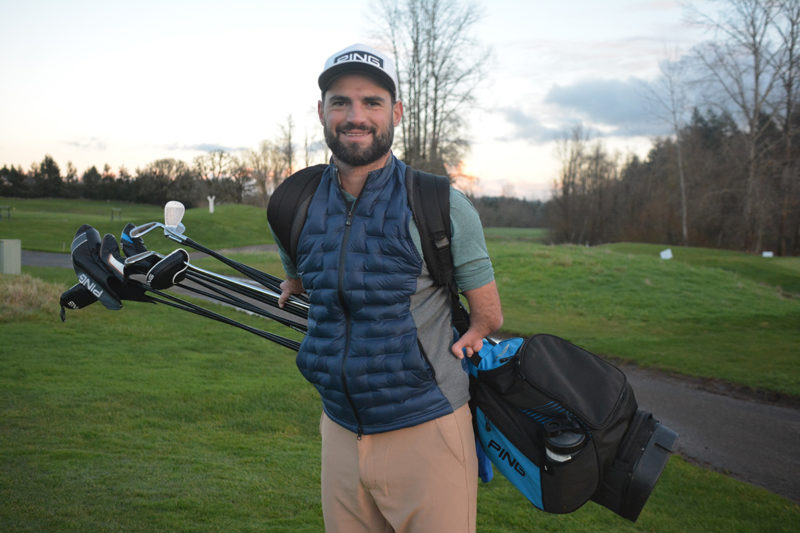
by Steve Brandon
He was born with arms that end at the elbows. He didn’t take up golf until he was in college. He has to get down on all fours just to tee up his ball. He’s never had a teacher.
And he can probably beat a lot of us from the white tees.
Meet 34-year-old Andreas Brandenberger of Salem, Oregon. Handicap: 15.5 and probably dropping.
Using PING clubs adapted to work with his physique, he routinely drives 220 to 230 yards, down the middle of the fairway.
In 2021, he lowered his lifetime-best 18-hole score six shots, shooting 81 at his home Creekside Golf Club in Salem.
“Had a chance to break 80, but I started looking at the score coming in,” he says, kicking himself. “Bogeyed the 18th.”
The 6-foot, 140-pound Brandenberger considers himself an athlete, and it’s impossible to argue that. He played youth soccer and made it to the Kansas state tournament as a high school wrestler, pinning a lot of opponents with his legs, which would put foes in a painfully effective scissors hold.
He likes to run trails, three to six miles at a time. He lifts weights and works out at a local gym, where he has figured out how to make use of the fitness equipment.
And, entirely self-taught, he has met his goals so far in golf.
“I wanted to be a bogey golfer or better,” he says.
Now Brandenberger is setting new goals for 2022 and beyond. One thing on his list is to compete more often. He’s excited that the USGA recently announced that this summer it will conduct the inaugural U.S. Adaptive Open, a national championship for the world’s best golfers with disabilities. The 54-hole, stroke play event will be held July 18-20 at famed Pinehurst Resort in N.C.
Brandenberger intends to be there, inside the ropes, with clubs and bag in tow.
He also hopes he can inspire others to take up what has become not just his favorite sport but a bit of an obsession.
He’s very driven to get better, to overcome any physical hurdles as well as the obstacles a golf course presents.
“Determination is in my blood,” he says.
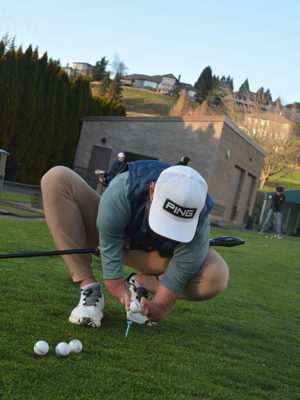
This comes from early childhood. Born near Athens, Greece, he was adopted at age two and grew up on a Kansas farm with his parents and five siblings, all older. His father, a former emergency room doctor in Roseburg who worked at the University of Kansas health clinic, instilled a work ethic that served young Andreas well and continues to help him succeed in all aspects of life.
“There was always something to be done – mowing, gardens, there was always a project,” Brandenberger says.
For as long as he can remember, he has done things for himself, found a way.
“Yeah, I pick up my fork and I put my food in my mouth,” he says. “You learn. As humans, we have adapted over the years, and you can learn to adapt in your own life, as well. I was born with Phocomelia (shortened arms) and adapted. I’m a very proud person, and I don’t like to ask for help.”
His family environment was about as far from the country club life, though, as Pinehurst is from Salem. And until he noticed some golf highlights playing on ESPN in the high school cafeteria, Brandenberger never gave the sport a thought.
Even then, about the only thought he gave it was that Tiger Woods was very good and a colorful dresser.
“Red has always been my favorite color, and Tiger would be wearing red,” Brandenberger says.
But that was pretty much that.
“I didn’t think I’d ever play golf,” Brandenberger says.
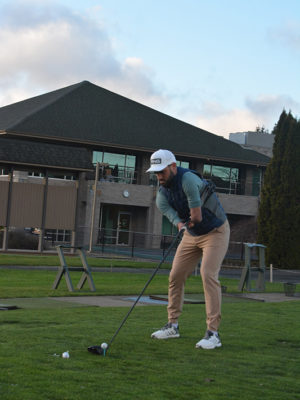
Until….
As a student at the University of Kansas, he heard of a man named George Utley, who has the same condition yet was playing golf.
Brandenberger went straight to the UK golf coaches’ office, showed them a video of Utley and said, “I think I can do this, but I need somebody to build me clubs.”
The coaches knew of someone in the area who could, and before long Brandenberger had a 3-wood, 7 and 9 irons, wedge and putter.
“The first time I swung the club, it flew out of my arms,” he recalls.
But it didn’t take long for the right-handed swinger to grasp how to keep the club against his upper left arm through the downswing and beyond impact, and he was on his way.
“Before I ever even hit a ball, I thought I could do it, I just had to figure out how to hold on to the club,” he says.
He does it by putting the club under his left armpit as it runs along the forearm. Because his right arm isn’t long enough, he has a one-arm follow-through, so every swing looks a bit like Tiger slashing the ball out of the heather at an Open Championship.
“My first round was 130 or 140 or something awful,” Brandenberger says.
Soon he was playing better, though, and working at a golf club in Kansas.
“I had plenty of naysayers, the jerks, the people who thought I wouldn’t be able to do things or succeed,” he says. “But I like showing others that it’s possible, and I just wanted to hit the ball and get out and play.”
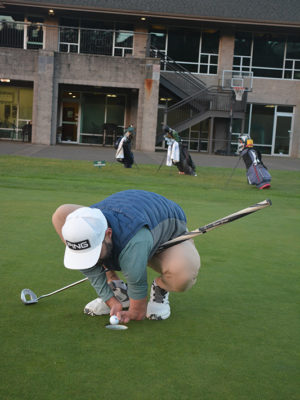
He didn’t get to play a lot, but eventually had a best score of 91. About five years after getting his first five clubs, Brandenberger got his biggest golfing break yet. He met someone with connections to PING and heard the company had made clubs for Wounded Warriors and others.
“I found out they love the challenge – they’re basically a bunch of engineers who love solving problems – so they took my case and ran with it and came back with awesome clubs for me,” Brandenberger said.
Since then, with his PING driver, hybrid 4- and 6-woods, 7 and 9 irons, pitching wedge, utility club, 60-degree wedge and Sigma 2 Fetch putter (which fits inside the hole and can help him get his ball out of the cup), Brandenberger has continued to shoot lower scores.
“I’m still nervous on the first tee, when I get in front of a group of people,” he says. “I feel there’s extra eyeballs on me. But no one really cares, honestly. It’s just that I always want to do my best when people are watching me.”
Brandenberger moved to Salem with fiance Emily Lohman, a Willamette University law school student. He works for the Oregon Department of Transportation, managing remediation of non-compliant pedestrian curb ramps and push signals.
“I enjoy this job, but I have always seen myself as someone who would work in sports, and with my love of golf, I hope to make that a reality someday. Combining business and golf would be ideal.”
He’s played in only two tournaments, and quickly realized it was “nerve-racking, a totally different experience versus casual golf.” But he placed second in his division in the second one, in May 2021.
He wants to become a single-digit handicapper and play in more adaptive golf tourneys. And maybe finding a teaching pro.
“My first goal is to remember to always have fun on the course,” he says. “The handicap is going to be a tough task, but I’ve never walked away from something because it is too hard, so I have full faith I will reach that goal.”
The biggest hurdle in competing in multiple adaptive tournaments is financial, but he says the long-term goal is that when adaptive golf is finally put into the Paralympics he will have put himself in position to have an opportunity to compete for Team USA and be competitive enough to medal. “I don’t plan to stop until I have reached that goal,” he say.
The hardest part of the game for him can be simply squatting to the ground in order to tee up his ball.
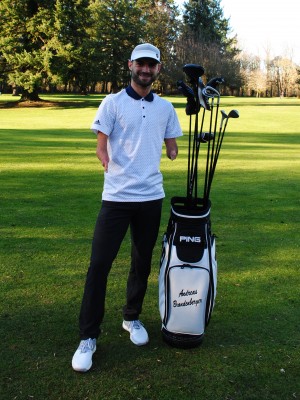
“I’m down there for a while, but it’s manipulating my hands to do those fine motor movements that’s the biggest challenge,” he said.
Not enough to deter him from his appointed rounds, however. He has fallen in love with the game, and the challenge of it, just as it challenges everyone else who has ever played it. His thoughts on the game sound like those of just about any golfer.
“Some days I feel like I hit the ball extremely well, other days I feel like I’ve forgotten how to hit a ball and I’m playing a different sport altogether,” he says.
He spends a lot of time on the range, trying different set-ups and ball positions, “lots of trial and error in hopes I can find that sweet, consistent, repeatable swing that works.” Sounds familiar.
His clubs are long, and even though they are made with a plastic composite material, are on the heavy side. He plays with a 66-inch driver. His wedge is 58 inches long.
“My driver is taller than some people I’ve played with,” he laughs.
So it takes athleticism to swing those sticks, let alone hit good shots. But he does.
“I can hit the drive out there 220-230, sometimes farther with a good bounce and roll,” he says. “My 7-iron I can get close to 160; I can launch it. I’m hitting a 9-iron 130 to 150, depending on the weather.”
A Bryson DeChambeau bomber he’ll never be. “275 off the tee I just can’t compete with,” he says.
But the trickiest shots for him are in the short game.
“The half- and two-thirds swings are a lot more difficult than a full swing,” he says. “It feels harder to hold on to the club. I will screw up those shots because I’m worried about the hold of the club as opposed to the impact and connecting to the ball.
“And hitting out of tall grass is tough, too, because it will grab the clubface.”
When it comes down to it, he’s like every other golfer in another matter-of-fact way – no two swings are exactly alike. Miller Barber’s swing didn’t look like Ben Hogan’s. Arnold Palmer didn’t swing like Bobby Jones.
It’s truly not how, but how many.
“However you do it doesn’t matter,” Brandenberger says. “At the end of the day, you need to put the ball in the hole, end of story.”
And still the beginning of his story.
Steve Brandon was the sports editor for the Portland Tribune from 2001-20, and sportswriter for The Oregonian from 1982-2001. In 2002, he was named the Oregon Sportswriter of the Year. He serves on the Oregon Sports Hall of Fame selection committee.





